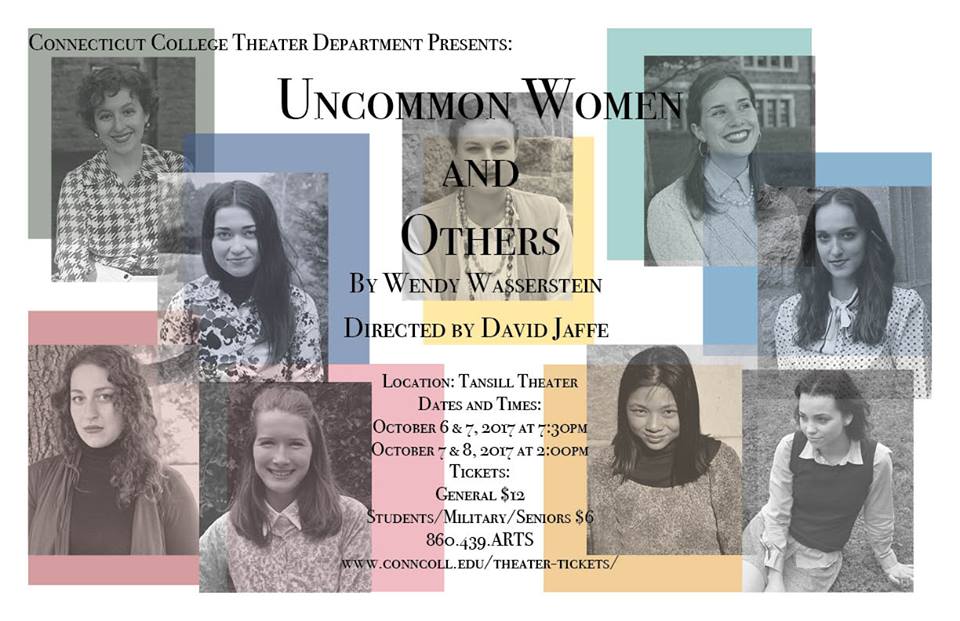Hillyer Hall was constructed in 1917 as the first gymnasium for Connecticut College for Women. It was the fifth building constructed by the College, and similarly to the building that preceded it, Winthrop House, it was constructed quickly with the intention that it be a temporary building; however, unlike Winthrop House, the space has been utilized more successfully.
Hillyer Hall’s original purpose was not superseded until Crozier-Williams opened in 1959, which provided space for both the Physical Education Department and the College’s social events and dances. The construction of Crozier-Williams led to the conversion of Hillyer Hall into a space for the print shop, bookstore and post office. In 1998 the space was again renovated to create a black box theater for the College. Now known as Tansill Theater, the space regularly hosts mainstage productions by the Theater Department including their most recent: Wendy Wasserstein’s Uncommon Women and Others, directed by David Jaffe. The play focuses on the experiences of a group of seniors at Mount Holyoke College in the early 1970s.
There are many contrasts in this play, some of them sharp and sudden. In the early of years of Conn, men assumed that women could not succeed academically without rigorous physical education, and the play reflects similarly antiquated ideas about women’s education. This is highlighted by its transitions between scenes where a man’s voice, here Jaffe’s, is heard reading excerpts from the Mount Holyoke College catalogue and related materials, at one point describing an educated woman as successful, even relative to men, on the grounds of being “the second best cook…third best parent, the seventh best typist, and the tenth best community leader.” In the final scene, this transforms into a woman’s voice acknowledging the obstacles educated women face in gaining recognition. For these closing remarks, Jaffe’s production featured the voice of Katherine Bergeron, an ironic touch, given that Jaffe graduated from Conn, whereas Bergeron graduated from Wesleyan, the historically male university that warranted Conn’s foundation.
The voiceover is juxtaposed with deep discussions between the students on topics ranging from the veracity of Sigmund Freud’s theory of penis envy to ideas of second-wave feminism. We see Rita Altabel, played by Lindsey Ruzza ’18, brag many times about tasting her own menstrual blood and Holly Kaplan, played by Lizzy Moreno ’18, struggle with inserting a diaphragm into her vagina. At times the characters also need to get away from all the issues confronting them in college. In one scene Rita and Samantha Stewart, played by Gabrielle Schlein ’18, attempt to act incredibly macho towards each other. This contrasts deeply with the occasional appearances of a piglet doll owned by Samantha, a playful and innocent touch in the performance.
In terms of venue, Tansill Theater makes a particularly interesting choice for this play, given the building’s history. Back when Tansill was known as Hillyer Hall, the College required students to take gym class, falling in line with the requirements of other women’s colleges as it was believed that women who developed healthy bodies would be prepared for the mental challenges of higher education. Because Crozier-Williams was not yet established, these classes would have occurred in the exact space where Uncommon Women and Others was performed. Although the script calls for a realistic set depicting the characters’ dormitory at Mount Holyoke, scenic designer Sara Ossana has instead created a series of abstract platforms that have the appearance of couches or beds that the women perform on or observe from throughout the play. The abstract nature of the set may be all the more enhanced by the venue’s own history as part of a traditional women’s college.
At one point in the play, the characters discuss why they chose Mount Holyoke over other women’s colleges, and Conn, having a couple years prior to the play begun accepting men, makes an appearance towards the end of this passage, being described as slightly worse than Vassar because of the proximity of Coast Guard men. These lines drew hearty laughter from the audience attending the matinee performance on the Saturday of Fall Weekend.
Overall the cast gave a very strong performance, and Jaffe made some very smart casting choices, including the decision to cast five seniors as the five principal seniors characters at the college, which Jaffe highlighted in an interview with the Voice. I’d also highlight the contrast between Chiara Gero ’18, who played Kate Quin, and Audrey Black ’21, who played Carter. Gero’s character Kate, a senior, is the member of Phi Beta Kappa in the group. Over the course of the play she develops a friendship with Carter, a rather reserved freshman whose goals in life are never even hinted at. What was particularly strong about this casting was that Gero appears almost a foot taller than any of the other cast members, and thereby creates a visual where her success imposes itself over the others, from her first entrance it was clear that she was the focus of this production; this really contrasted with Quin, who certainly stands out, but is also one of the cast’s shortest members.
Moreno’s portrayal of Holly Kaplan was also very strong. The role is particularly difficult as it represents Wasserstein’s portrayal of herself at Mount Holyoke. Ruzza seemed to be having a great deal of fun portraying Rita and her energy certainly emanated through the room. Katie Rooney ’21’s Susie Friend was obnoxious to the point of utter despicability. Finally Sophie Bardos ’20’s Leilah, Kate’s estranged roommate, was extraordinarily poised and she seemed as though she had mastered the many facets of this complex character. In a theater whose walls surrounded them with institutional history, his dedicated and talented cast offered a poignant representation of the historical barriers encountered by women in higher education.









